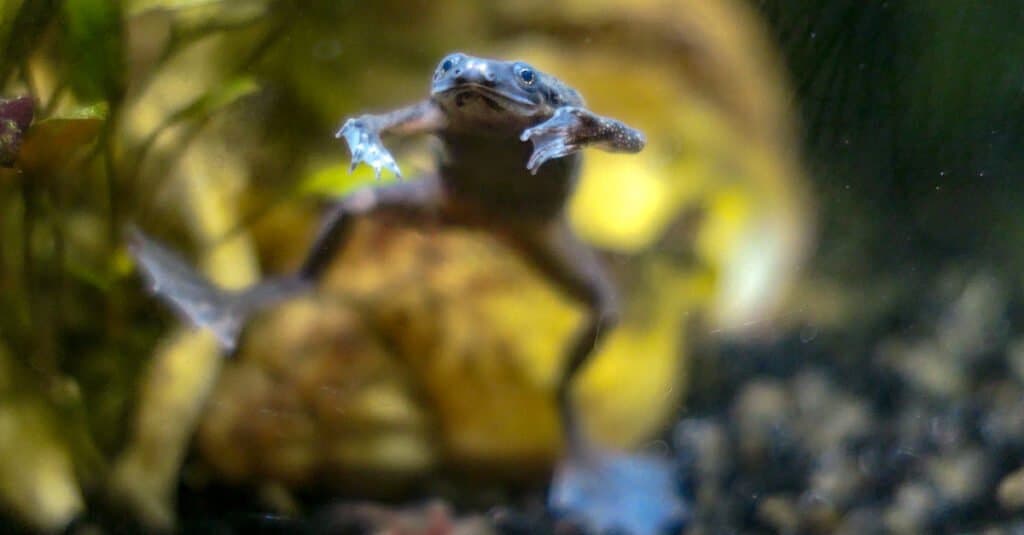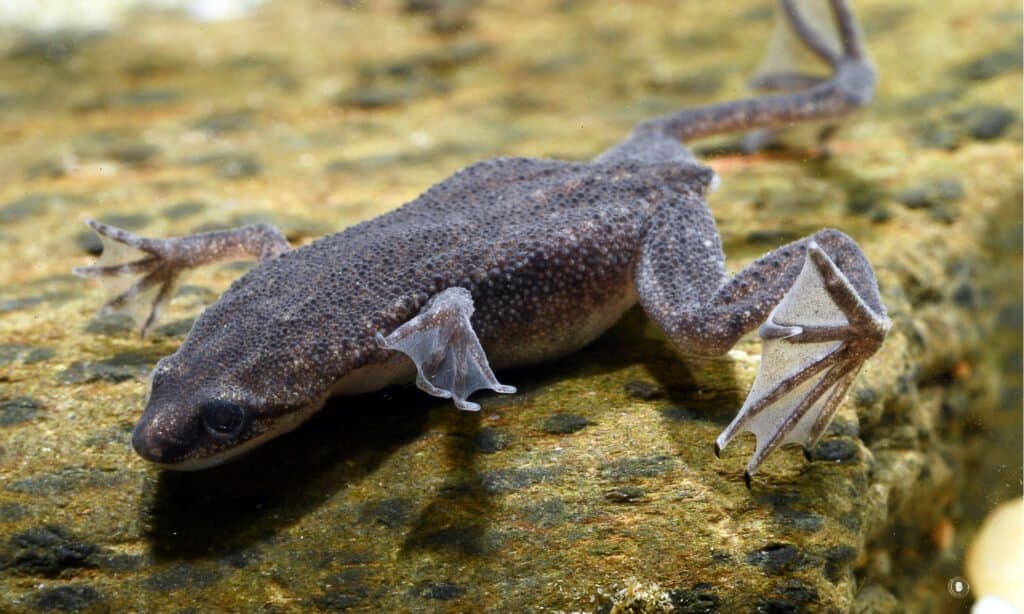Frogs are found in all shapes and sizes, but African dwarf frogs are particularly small amphibians, comprising four different species in the Hymenochirus genus. African dwarf frogs can be found both in the wild and in captivity, where they make captivating aquatic pets.
When you first adopt an African dwarf frog from a pet store, you might be alarmed by their small size. Most pet stores sell these frogs while they are still young and have not yet reached the final adult size. This article will discuss just how big you can expect your African dwarf frog to get.
A Bit About African Dwarf Frogs

The African dwarf frog is a small and lively amphibian from
Africa
.
©Charlie Tyack/Shutterstock.com
| Genus name: | Hymenochirus |
| Origins: | Equatorial Africa |
| Size: | 2 to 3 inches (5 to 7.5 cm) |
| Minimum tank size: | 10 gallon |
| Temperature: | 75° to 78° Fahrenheit (23 to 25 Celsius) |
| Lifespan: | Up to 5 years |
| Diet: | Omnivores |
The African dwarf frog’s location can vary depending on their species, although they all originate from Equatorial Africa. These frogs can also be found in the aquarium trade industry as pets. African dwarf frogs naturally inhabit ponds, rivers, and swamps, with a strong preference for water bodies with dense vegetation. They are fully aquatic, although they will occasionally come to the surface of the water to breathe. As social creatures, you need to keep African dwarf frogs in pairs or groups of three or more.
How Big Do These Frogs Get?
African dwarf frogs are one of the smallest pet aquatic frogs you can own, with an adult size of 2 to 3 inches. They grow to a similar size in both captivity and in the wild, although some specimens might be smaller than others. Regardless, African dwarf frogs rarely grow larger than 3 inches long from snout to vent and weigh around 0.035 ounces.
They are sexually dimorphic frogs with visible differences between the male and female in terms of size and appearance. Male African dwarf frogs are around 40% smaller than the females and lack the plump appearance typical of gravid females. The females are about 1 to 1.5 inches longer and heavier than the males, with a noticeably rounded belly.
African dwarf frogs have a hearing structure on their heads known as a tympanum. The male’s tympanum is slightly larger than the female’s, which can make his head look slightly larger. Despite their larger tympanum, male African dwarf frogs still remain smaller than the females.
Species Size Comparison Guide
There are four main species of African dwarf frog in the Hymenochirus genus and the Pipidae family. The different species are difficult to tell apart due to their similarity in appearances, hence why we simply refer to them collectively as African dwarf frogs.
| Species | Size |
|---|---|
| Zaire dwarf clawed frog | 2 to 3 inches |
| Gaboon dwarf clawed frog | 2 to 2.5 inches |
| Western dwarf clawed frog | 1.2 to 2.2 inches |
| Eastern dwarf clawed frog | 1.2 to 3 inches |
1. Zaire Dwarf Clawed Frog (H. boettgeri)

The Zaire dwarf clawed frog is commonly kept as aquarium pets.
©Guillermo Guerao Serra/Shutterstock.com
The H. boettgeri is the most popular species of African dwarf frog kept as pets. Zaire dwarf clawed frogs were the first species to be described by Tornier in 1896, and scientifically known as Xenopus boettgeri. This species was later reclassified into their own genus. Zaire dwarf clawed frogs are found throughout Cameroon, Gabon, and Nigeria.
You can recognize a Zaire dwarf clawed from by their brown to grey-colored bodies covered with dark blotches. This species can grow between 2 to 3 inches long, although some are smaller at only 1.5 inches in size. Pet stores typically sell Zaire dwarf clawed frogs when they are 1 inch long, and the frog still has the opportunity to grow in your care.
2. Gaboon Dwarf Clawed Frog (H. feae)
The Gaboon dwarf clawed frog is endemic to Gabon and was described in 1906 by Boulenger. There is little information available on this specific species of African dwarf frog, including their population size. What we do know is that the Gaboon dwarf clawed frog is ecologically similar to the H. boettgeri and inhabits slow-moving waters in lowland rainforests.
The size of the Gaboon dwarf clawed frog is estimated to be the same as the H. boettgeri at around 2.5 inches. It is unclear whether this species is kept in captivity or mistaken for the other species.
3. Western Dwarf Clawed Frog (H. curtipes)
Western dwarf clawed frogs are found in the Democratic Republic of the Congo, and the southern part of the Central African Republic. This species has a brown coloration and black spotting on their bodies.
Like the Gaboon dwarf clawed frog, the Western species are ecologically similar to the H. boettgeri. You can find them in lowland rainforests, flooded forests, and pools alongside rivers. Western dwarf clawed frogs are indeed kept as pets according to the IUCN Red List.
In captivity, Western dwarf clawed frogs have a small size of 1.2 to 2.2 inches long. They seem to be slightly smaller than the Zaire dwarf clawed frog.
4. Eastern Dwarf Clawed Frog (H. boulengeri)
Eastern dwarf clawed frogs were described in 1930 by De Witte. This species is endemic to The Democratic Republic of the Congo where they inhabit inland wetland forests. It is unclear whether this species is recognized as a pet like the Zaire and Western dwarf clawed frogs are. The exact size of the Eastern dwarf clawed frog is unknown. However, they are likely between 1.2 to 3 inches long as most species in the Hymenochirus genus are.
African Dwarf Frog vs. African Clawed Frog Size

An African clawed frog does not have webbed forelimbs, whereas the African dwarf frog does.
©Christophe cagé / CC BY-SA 3.0 – License
It can be disappointing to set up an aquarium for a small species of frog only to end up with an 8-inch-long frog instead. This is a common issue when pet stores mislabel African dwarf frogs to a similar species — the African clawed frog.
African clawed frogs, scientifically known as Xenophus laevis, look strikingly similar to juvenile African dwarf frogs. However, they are two different species of frogs that vary in size. While the African dwarf frog’s size is true to the “dwarf” in their name, the African clawed frog is not. The average size for an adult African clawed frog is 5 to 8 inches with a weight of two ounces. This is much larger than African dwarf frogs who do not exceed 3 inches.
Although it can be challenging to determine between the species, it is possible. The main difference is that African dwarf frogs have webbed forelimbs, while the African clawed frog does not. Other distinguishing features between the two is that African clawed frogs have eyes on top of their head and a flatter snout.
When Are African Dwarf Frogs Fully Grown?
African dwarf tadpoles have rapid growth rates and develop their hind legs after four weeks. Their growth rate remains steady until the nine-to-12-month mark, when they become sexually mature and fully grown.
Conclusion
African dwarf frogs are small species of amphibians that grow between 2 to 3 inches long. They weigh only a few ounces and can be stocked in tanks as small as 10 gallons. While they do make fascinating pets, African dwarf frogs require proper living conditions and a healthy diet to thrive.
The photo featured at the top of this post is © Ashley Magyar/iStock via Getty Images
Thank you for reading! Have some feedback for us? Contact the AZ Animals editorial team.







